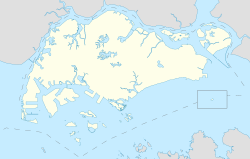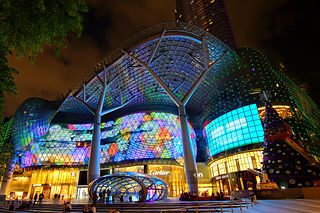
Orchard Road, often known colloquially as simply Orchard, is a major 2.5 km (1.6 mi)-long road in the Central Area of Singapore. A famous tourist attraction, it is an upscale shopping area, with numerous internationally renowned department stores, shopping malls, restaurants, and coffeehouses located in its vicinity. It is a popular hotspot in Singapore, especially at night, attracting trendy urban youth.

Dhoby Ghaut MRT station is an underground Mass Rapid Transit (MRT) interchange station on the North South, North East and Circle lines in Singapore. Located beneath the eastern end of Orchard Road shopping belt in Dhoby Ghaut, Museum Planning Area, the station is integrated with the commercial development The Atrium@Orchard. The station is near landmarks such as The Istana, the MacDonald House, Plaza Singapura and Dhoby Ghaut Green.

Clarke Quay MRT station is an underground Mass Rapid Transit (MRT) station on the North East line (NEL) in Singapore. Situated along Eu Tong Sen Street, near the junction of Merchant Road and North Canal Road, it is at the south of the Singapore River underneath The Central. The station serves Clarke Quay and Boat Quay, as well as other landmarks such as Hong Lim Park, The Riverwalk and the Swissotel Merchant Court.

The Singapore River is a river that flows parallel to Alexandra Road and feeds into the Marina Reservoir in the southern part of Singapore. The immediate upper watershed of the Singapore River is known as the Singapore River Planning Area, although the western part of the watershed is classified under the River Valley planning area.

Marina Bay is a bay located in the Central Area of Singapore, surrounded by the perimeter of four other planning areas, the Downtown Core, Marina East, Marina South and Straits View. The area surrounding the bay itself, also called Marina Bay, is a 360 hectare extension to the adjacent Central Business District. It is also the new downtown of Singapore, built on Singapore's reclaimed land.
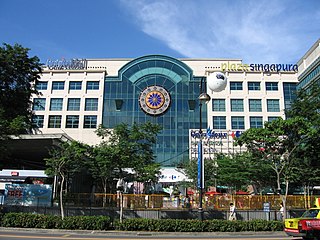
Dhoby Ghaut is a place in Singapore that often refers to the MRT station of the same name, which is a major interchange station on Singapore's Mass Rapid Transit network connecting the North-South Line, North East Line, and the Circle Line. As a place, Dhoby Ghaut lies along the eastern end of Orchard Road. There is a shopping mall above the MRT station called Plaza Singapura.

Somerset MRT station is an underground Mass Rapid Transit (MRT) station on the North–South Line in Orchard, Singapore. It is one of the three stations located along the popular shopping belt, Orchard Road.

Promenade MRT station is an underground Mass Rapid Transit (MRT) interchange station on the Downtown (DTL) and Circle (CCL) lines in Downtown Core, Singapore. Located underneath Temasek Avenue and adjacent to Millenia Tower, the station serves several key attractions and locations such as Suntec City and the Marina Promenade, which the station is named after. The station is at the junction of the Dhoby Ghaut and Marina Bay branches of the CCL.

Bras Basah MRT station is an underground Mass Rapid Transit (MRT) station on the Circle line (CCL) located in the Museum planning area, Singapore. It is underneath Bras Basah Road, bordering Waterloo Street and Queen Street. Located next to the Singapore Management University (SMU), this station is in proximity to the National Museum of Singapore, the Singapore Art Museum, Peranakan Museum and School of the Arts, Singapore. The station is connected to the nearby Bencoolen station on the Downtown line (DTL) via an unpaid link.

Esplanade MRT station is an underground Mass Rapid Transit (MRT) station on the Circle Line (CCL) in Singapore. Situated in the Downtown Core, it is at the junction of Bras Basah Road, Raffles Boulevard and Nicoll Highway. As the name suggests, the station serves the Esplanade performing arts centre, alongside various developments such as War Memorial Park, Suntec City Mall and the Suntec Singapore Convention and Exhibition Centre. Esplanade station is linked to the nearby City Hall station via CityLink Mall, an underground retail development.
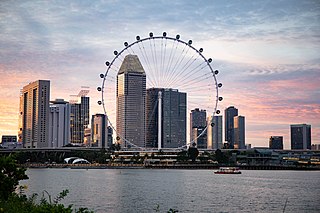
This article shows the notable future developments in Singapore. Most of them are currently under construction with most to be completed within the next five years.

Waterloo Street is a two-way street in downtown Singapore stretching from Rochor Road to Bras Basah Road. It passes through the planning areas of Rochor and Museum Planning Area.

Bras Basah Road is a one-way road in Singapore in the planning areas of Museum and Downtown Core. The road starts at the junction of Orchard Road and Handy Road, at the ERP gantry towards the Central Business District, and ends at the junction with Nicoll Highway, beyond which it becomes Raffles Boulevard. Several landmarks including Fairmont Singapore, Raffles Hotel, Singapore Art Museum, Cathedral of the Good Shepherd and the Singapore Management University are located along the road. A MRT station with the same name, Bras Basah MRT station, is on the Circle Line.

Queen Street is one of the oldest streets in Singapore and once had a very strong Eurasian presence. Beginning at Arab Street, Queen Street forms major junctions with Ophir Road, Rochor Road, Middle Road and Bras Basah Road before ending at the junction of Stamford Road.

Fort Canning Tunnel, abbreviated as FCT, is a vehicular tunnel in the Central Area of Singapore.

The Old National Library Building was a historical library building at Stamford Road in the Museum Planning Area of Singapore. Originally completed in 1960, the library building was a national icon for many Singaporeans. Despite a huge groundswell of public dissent, the library was closed on 31 March 2004, and was demolished in July that year to make way for the construction of the Fort Canning Tunnel to ease road traffic to the city. The controversy surrounding the building's demise has been credited for sparking greater awareness of local cultural roots and an unprecedented wave in favour of heritage conservation among Singaporeans.
Kaplan Singapore is a for-profit private education institution headquartered in Singapore with other campuses in Hong Kong, Taiwan, and the People's Republic of China. It was known as the Asia Pacific Management Institute (APMI) before it was acquired by Kaplan Inc., a subsidiary of the Graham Holdings Company, in May 2005.

Sri Sivan Temple is a Hindu temple in Singapore for the god Shiva. The temple was originally located in Potong Pasir from where it was moved three more times before finally coming to the present location, adjacent to Foo Hai Ch'an Buddhist Monastery, in front of Paya Lebar MRT station exit C at Geylang East Avenue 2.
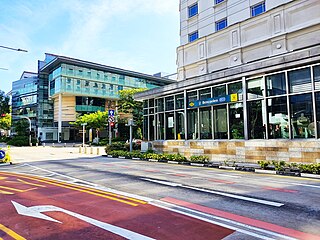
Bencoolen MRT station is an underground Mass Rapid Transit (MRT) station on the Downtown Line (DTL) in Singapore. Located under Bencoolen Street, the station serves primarily the Nanyang Academy of Fine Arts (NAFA), Singapore Management University and surrounding developments. At 43 metres (141 ft) below street level, Bencoolen is the deepest station in Singapore.
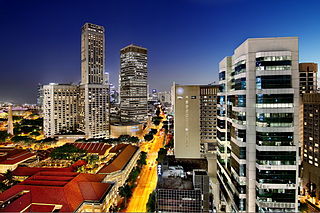
Bras Basah is a district located in the Museum Planning Area of the Central Area of Singapore. Bras Basah means "wet rice" in Malay – beras means harvested rice with husk removed, and basah means wet.








